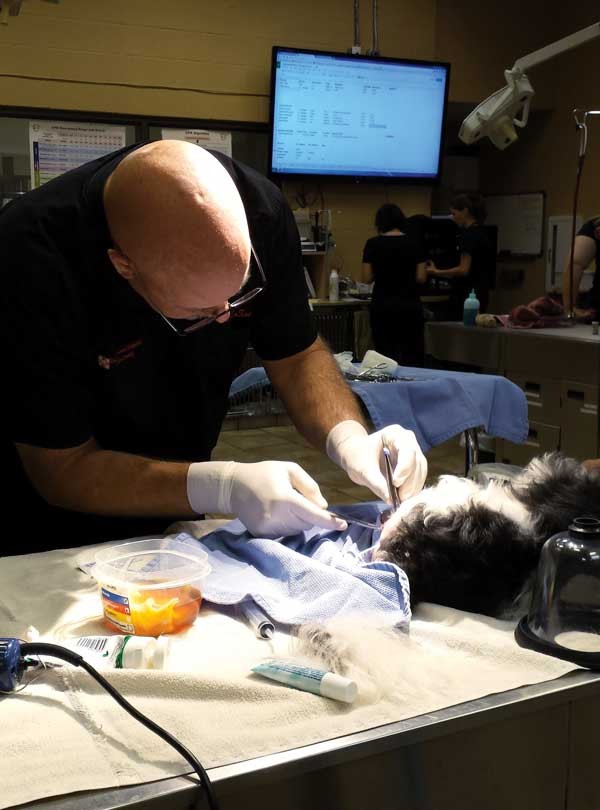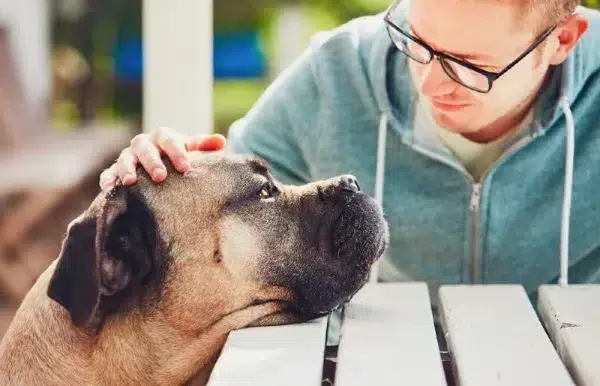At 7 p.m. Saturday, I entered through the door marked STAFF ONLY and into a place many of us pet parents fear and rarely see: the treatment area of an emergency animal hospital.
I stepped back to avoid colliding with a veterinary technician rushing in from the lobby with a Jack Russell Terrier in her arms. The dog’s mouth was swollen after being bitten by a suspected venomous snake.

Once inside, I stood in the middle of the large treatment area at the Emergency Animal Hospital of Collin County in Plano, Texas. As I slowly made a 360-degree turn, I spotted a Bulldog puppy panting inside an oxygen tank, a Shih Tzu on a stainless steel exam table with a bloody dog bite wound on his rump, and a sweet Shepherd mix on the floor gently wagging his tail as two veterinary technicians worked to stop the bleeding caused by yanking a nail from his front paw.
Welcome to a Dogster exclusive behind-the-scenes tour of an emergency animal hospital, a place where lives are saved and, sadly, goodbyes are said. And, as I discovered after completing a pair of midnight shifts, the ER is a noisy place with controlled chaos. Staff members speak quickly to one another in a special, abbreviated code. Time speeds by.
“Basically, we can handle most of the things handled in a human ER — we have the equipment to do that,” said Dean Severidt, DVM, chief medical officer. “In looking for a good ER staff, we look to hire people who can handle multiple tasks at once, who don’t get frustrated easily when things aren’t going right, and who like to be up in the middle of the night.”
That’s a job description that suits Catherine Murphy. She is the charge veterinary technician here. “I started as a vet tech in 1997, and I love it,” she said. “I’ve never gotten tired of it. At the end of the shift, you feel you are doing something good for both the pets and their human counterparts.”
Diego Rivas, a former car mechanic, now “repairs” ailing pets. This vet tech was sitting on the floor, keeping tabs on a Labrador mix and a Golden Retriever mix who were admitted with suspected cases of the highly contagious disease called leptospirosis. This disease affects the kidneys and is normally transmitted by rodents and stagnant water. “And it is zoonotic, meaning it can be transmitted to people,” added Rivas. “That’s why I am wearing PPE — personal protective equipment — and being very careful not to come into contact with these dogs’ urine and saliva. I liked being a mechanic, but here, I can make a real difference. I get to save lives.”

Heather LoSasso, DVM, gave a thorough physical examination to a small, fluffy dog
with two noticeable deep puncture wounds on the left side of her neck. Dr. LoSasso fingered through the thick hair on the right side of the neck and discovered two matching puncture wounds.
“In a dog fight, dogs don’t normally just bite with the top part of the mouth or the bottom part,” she said. “That’s why I was looking for the corresponding wounds on the right side of the neck, and found them. Most of the time, we like to clean these bite wounds and close them because there is dead space — the skin has separated from the muscle. If we leave them unattended, they can develop into abscesses.”

Her husband, Mike LoSasso, DVM, was petting the 15-year-old Pomeranian named Kirby before honoring his owner’s request to euthanize him. “The problem is that you typically treat chronic renal failure with aggressive fluid therapy, but dogs with congestive heart failure cannot take aggressive fluid therapy,” Dr. LoSasso said. “Kirby has both. At this point, it is time to say goodbye to the sweet little Kirby. It’s one of the downsides of really loving and giving yourself to your pets. You have to make the ultimate act of kindness, and it is tough.”

Sitting in the lobby are Teela and Josh Mellus. Four hours earlier, they came in with Ramsey,
a Jack Russell Terrier, who they fear had eaten some rat bait while inside a neighbor’s open garage. Ramsey was given charcoal to coat his gastrointestinal tract and prevent any reabsorption of the suspected toxin. He was on intravenous fluids and fitted with what the staff calls “a seizure bell” before being put in a cage to be monitored.
“We’re always watching our patients, but this seizure bell gives us a chime sound we can hear,” said Carrie Coats, a vet tech of 27 years. “These seizure bells work great to alert us to patients at risk for seizures, tremors, and other neurological issues.”

At 1 a.m., the staff had stabilized Ramsey, who was ready to go home. As they carried Ramsey out the hospital’s exit doors, Teela turned and said, “We are not sure how much (rat bait) he actually ate. The way I look at it, this is going to cost us a lot of money to take him to the emergency clinic, but at the end of the day, if we didn’t do anything, could we live with ourselves? Why Ramsey, he’s our little boy.”

Play it safe — for your pet’s sake!
Here is a rundown of conditions that warrant immediate veterinary attention:
- Arterial bleeding
- Massive trauma to the head, abdomen, or chest
- A broken leg or fractured ribs
- Deep cuts, bites, and puncture wounds
- Snake bites
- Poisoning
- Shock
- Bloat
- Dog is unconscious
- Seizure episode
- The dog is unable to walk
- The dog has difficulty breathing
Read related stories:


















